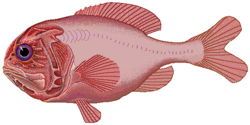bio.wikisort.org - Animalia
Hoplostethus atlanticus (Collet, 1889), comunemente conosciuto come pesce specchio atlantico o pesce specchio[1]) è un pesce d'acqua salata appartenente alla famiglia Trachichthyidae, appartiene all'ordine Trachichthyiformes per FishBase, WoRMS (World Register of Marine Species) e ITIS (Integrated Taxonomic Information System), appartiene all'ordine Beryciformes per NCBI (National Center for Biotechnology Information).
| Pesce specchio atlantico | |
|---|---|

| |
| Stato di conservazione | |
Specie non valutata | |
| Classificazione scientifica | |
| Dominio | Eukaryota |
| Regno | Animalia |
| Phylum | Chordata |
| Subphylum | Vertebrata |
| Infraphylum | Gnathostomata |
| Classe | Osteichthyes |
| Sottoclasse | Actinopterygii |
| Superordine | Acanthopterygii |
| Ordine | Beryciformes |
| Famiglia | Trachichthyidae |
| Specie | Hoplostethus |
| Sottospecie | H. atlanticus |
| Nomenclatura binomiale | |
| Hoplostethus atlanticus Collet, 1889 | |
| Sinonimi | |
|
Hoplostethus gilchristi (Smith, 1935) | |
Distribuzione e habitat
Il pesce specchio atlantico è diffuso nell'oceano Atlantico, nell'Indiano, nel Pacifico occidentale. Non vive nel mar Mediterraneo. Vive sulla scarpata continentale o sulla piana abissale a profondità da 180 a 1809 metri[2].
Descrizione
La testa è molto grande e tozza, ricca di pieghe e ossa sporgenti, la bocca è girata verso l'alto, dotata di piccoli denti disposti in file. Il corpo è ovaloide, molto compresso ai fianchi, con peduncolo caudale allungato. Le pinne sono arrotondate, rette da grossi raggi. La pinna caudale è bilobata.
La livrea è molto semplice: tutto il corpo è rosso, con sfumature che variano dall'arancio al rosso carminio. L'interno della bocca e delle branchie è bluastro[2].
Raggiunge una lunghezza massima di 75 cm per 7 kg, più comunemente la taglia arriva a 40 cm[2].
Biologia
È uno dei pesci ossei dalla vita più lunga: sono stati pescati esemplari di 149 anni[2].
Riproduzione
La biologia della specie è poco nota, si crede che i giovanili vivano in acque profonde. L'accrescimento è molto lento[2].
Alimentazione
H. atlanticus si nutre di crostacei (anfipodi, eufausiacei e gamberetti), cefalopodi e di pesci. Gli esemplari giovanili predano piccoli crostacei[2].
Predatori
È preda abituale di Ruvettus pretiosus, Diastobranchus sp. e Merluccius merluccius[3].
Pesca
Ha una notevole importanza per la pesca commerciale in certe aree. Nel 2006 è stata dichiarata specie minacciata dal governo australiano a causa della sovrapesca[2].
Note
- Denominazione obbligatoria in Italia per tutti i membri del genere Hoplostethus ai sensi del DM 31 gennaio 2008
- (EN) Hoplostethus atlanticus, su FishBase. URL consultato il 27.08.2014.
- (EN) Sommario dei predatori da Fishbase
Altri progetti
 Wikimedia Commons contiene immagini o altri file su Hoplostethus atlanticus
Wikimedia Commons contiene immagini o altri file su Hoplostethus atlanticus Wikispecies contiene informazioni su Hoplostethus atlanticus
Wikispecies contiene informazioni su Hoplostethus atlanticus
Collegamenti esterni
- (EN) Hoplostethus atlanticus, su FishBase. URL consultato il 27.08.2014.
На других языках
[en] Orange roughy
The orange roughy (Hoplostethus atlanticus), also known as the red roughy, slimehead and deep sea perch, is a relatively large deep-sea fish belonging to the slimehead family (Trachichthyidae). The UK Marine Conservation Society has categorized orange roughy as "vulnerable to exploitation". It is found in 3 to 9 °C (37 to 48 °F), deep (bathypelagic, 180-to-1,800-metre (590 to 5,910 ft)) waters of the Western Pacific Ocean, eastern Atlantic Ocean (from Iceland to Morocco; and from Walvis Bay, Namibia, to off Durban, South Africa), Indo-Pacific (off New Zealand and Australia), and in the eastern Pacific off Chile. The orange roughy is notable for its extraordinary lifespan, attaining over 200 years. It is important to commercial deep-trawl fisheries. The fish is a bright, brick-red color, fading to a yellowish-orange after death.[fr] Hoplostèthe orange
Hoplostethus atlanticus- [it] Hoplostethus atlanticus
[ru] Атлантический большеголов
Атлантический большеголов, или атлантический слизнеголов, или исландский берикс[1] (лат. Hoplostethus atlanticus), — вид крупных глубоководных лучепёрых рыб семейства большеголовых (Trachichthyidae). По сведениям Общества охраны моря (Marine Conservation Society), является видом, находящимся под угрозой[2].Другой контент может иметь иную лицензию. Перед использованием материалов сайта WikiSort.org внимательно изучите правила лицензирования конкретных элементов наполнения сайта.
WikiSort.org - проект по пересортировке и дополнению контента Википедии

